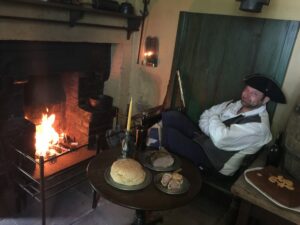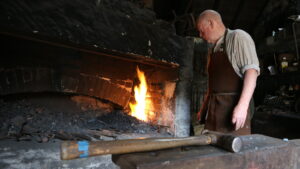Under Construction
Visitors will be able to experience the heat, sounds and smells of the Georgian blacksmith’s workshop in our smithy in The 1820s Landscape.
Our replica Georgian blacksmith’s will be a simple structure with a tiled roof and will illustrate the reliance on the handmade during the early industrial period, before the rise of mass production in the Victorian era.
Visitors will be able to see traditional metal forging taking place and learn more about this important heritage skill.
A Georgian blacksmith would have provided an essential service in all settlements; making domestic items from door furniture, to nails, cooking pots and decorative goods, as well as mending agriculture tools and machinery.
Unless connected to an estate or farm, a blacksmith’s workshop would have been located on a village green or main road junction, close to passing trade and would have taken work from local businesses. In the context of our 1820s developments, a local blacksmith would have done jobs such as repairing the iron bands around pottery kilns, making and fixing quilting shuttles and needles, or mending lime rakes and carts. If a blacksmith’s was located next to a coaching inn, the smithy would have derived a great deal of its business from re-shoeing the horses of coachmen and travellers, as well as repairing iron coach tyres.
Blacksmiths sometimes had other local duties. Farriers would often supply remedies for sick horses or create special shoes to help cure lameness. The practice of farriers tending their equine clients’ health was only stopped in 1880 with the Veterinary Surgeons Act. A wood engraving in the Beamish collection (probably made by William of Alnwick in the early 19th century) suggests that the blacksmith also doctored their human customers too.
Related Exhibits
Georgian Pottery

We will expand the range of early cottage industries which visitors can experience with the introduction of a small Georgian pottery in The 1820s Landscape.
Read moreThe Quilter's Cottage
Discover the fascinating story of renowned Georgian quilter Joseph Hedley as you visit the recreation of his beautiful heather-thatched cottage in our 1820s Landscape.
Read moreDrovers' Tavern

Visitors will be able to enjoy Georgian inspired food and drink at the new Drover’s Tavern based in the farm buildings behind Pockerley Old Hall.
Read more
